Contributory members are able to log private notes and comments about each site
Sites Anne T has logged. View this log as a table or view the most recent logs from everyone
Horseshoe Wood (Hownam)
Date Added: 24th May 2015
Site Type: Standing Stone (Menhir)
Country: Scotland (Scottish Borders)
Visited: Yes on 4th May 2015. My rating: Condition 3 Ambience 4 Access 3

Horseshoe Wood (Hownam) submitted by Anne T on 8th May 2015. One of the broader faces of this enigmatic standing stone in its gloriously scenic setting.
(View photo, vote or add a comment)
Log Text: Horseshoe Wood Standing Stone, Hownam, Scottish Borders: Note, when parking in the village and starting up The Street, in the field immediately to the right hand side of The Street, there appears to be what might be another standing stone or stones at grid reference NT 77991 19158. I coudn't find out anything about this apart from a brief mention on (dare I mention it! the Modern Antiquarian site).
From our parking spot in Hownam Village, The Street climbs slowly, steadily (and for the unfit, steeply!) up into the hills, although taken steadily it’s easy walking along a farm track. The views of the surrounding hills are impressive. Passing Horseshoe Wood with its possible settlement/mound, you turn the corner and see the standing stone sticking up out of a pair of banks to your right hand side.
There has obviously been modern quarrying nearby – the scars are visible with stones scattered around the area between the end of the wood and the standing stone. Ignoring these, this spot is beautiful with stunning views to the south.
The standing stone sits easily in the landscape on top of an elongated oval mound that we found has been scooped out at the far end – a quarry, or naturally shaped? My conclusion was that it was quarried in modern times, not very sympathetically.
The Canmore/RCAHMS notes say that in 1968 and 1979 this stone was leaning at an angle of 55 degrees. It is upright now, so has been re-seated at some time.
The Street continues up in between the Headshaw Law and Windy Law to your right and Hownam Rings to the left. Towards the top of the hill there is a signpost, and a left hand turn takes you towards The Shearers. Half way up the hill, to the right hand side of the track at grid reference NT 79015 19018 there is a reasonably sized boulder which sits on its own. For some reason I glanced at this rock and noticed an indentation. Looking more closely, I’m convinced this is a cup mark with a possible ring around it.
The Shearers
Date Added: 8th May 2015
Site Type: Stone Row / Alignment
Country: Scotland (Scottish Borders)
Visited: Yes on 4th May 2015. My rating: Condition 3 Ambience 4 Access 3
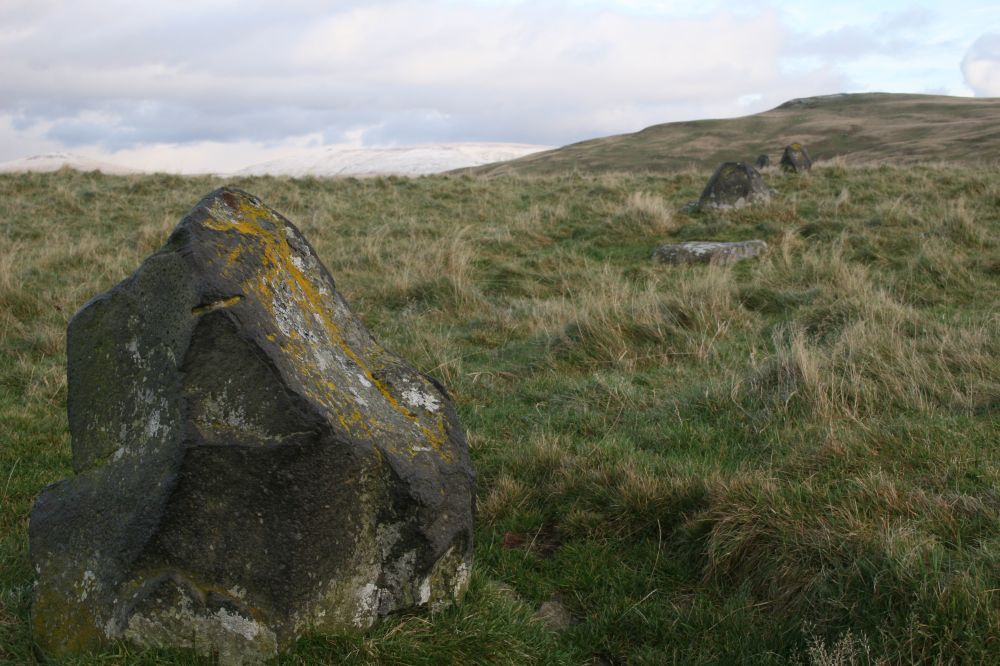
The Shearers submitted by minteddy on 18th May 2009. NT79101925. The Shearers. This view is looking east. Cheviot is the snow covered hill in the background. This photo was taken at the end of October 2008. The area is full of ancient remains, Roman roads and camps.
Five Stanes stone circle and Trestle cairn, the Roman Road of Dere Street are barely 5 km to the west. The path way up to the Shearers follows the line of the ancient track way "The Street" through the Cheviot Hills. It is truly a magical area. I love it.
(View photo, vote or add a comment)
Log Text: The Shearers Stone Row, near Hownam, Scottish Borders: Continuing on from the Horseshoe Wood Standing Stone, continuing up the hill, towards the top of the hill, but not quite, the pathway divides. To the left runs a path to Belford, with The Street leading to Alwinton.
Turning left towards The Shearers and Hownam Rings Hill Fort, we needed to go through two gates and track across the field rather than follow the signposted path. We noticed (more on the return journey due to the evening light) an earthwork. It was particularly evident near the two gateways by the signpost. According to the Canmore/RCAHMS record (341447) it is an earthwork of uncertain date, but very like the medieval estate boundaries we’ve been looking with the local archaeology group at Davy’s Lee in Northumberland.
There is no formal track across the tussocky grass, so the walking was a little trickier, but not impossible - there are plenty of sheep tracks to avoid turning your ankles. I saw at least three pairs of boulders in the grass leading from the Street to the Shearers – could these possibly be signposts to this monument, such as at the Loupin’ Stanes and the Girdle Stanes?
Standing in the middle of The Shearers it felt like being in the middle of a shallow bowl with a view only to the west. Following the row to its western end, it appeared to end in a boggy area – was this deliberate?
Hownam Rings Hill Fort was only 100 metres to the north and clearly visible above the Shearers.
Jedburgh Rock Art
Date Added: 23rd May 2015
Site Type: Rock Art
Country: Scotland (Scottish Borders)
Visited: Visited (still working on) on 23rd May 2015
Log Text: Jedburgh Rock Art: We spotted this site page after our last visit to Jedburgh earlier this month, and having missed this piece of rock art first time round, we decided to stop when we next passed through to see if we could find it. Armed with SolarMegalith's grid reference, we went scouting, but were unable to find any rock or boulders in the vicinity.
I called up this page on my mobile phone and went into the visitor centre to ask if they knew anything about it. Neither of the guides knew anything about this at all, taking my phone to consult each other, and even double-checking the guide book to find out where the courtyard referred to in the earlier reference might be.
In the end, we all had to admit defeat on this occasion, but I'd be interested to find out if this piece of rock art has been moved to a local museum. Curious! I'd now love to found this stone and post a photograph.
Horseshoe Wood Settlement
Date Added: 24th May 2015
Site Type: Ancient Village or Settlement
Country: Scotland (Scottish Borders)
Visited: Yes on 4th May 2015. My rating: Condition 2 Ambience 4 Access 3
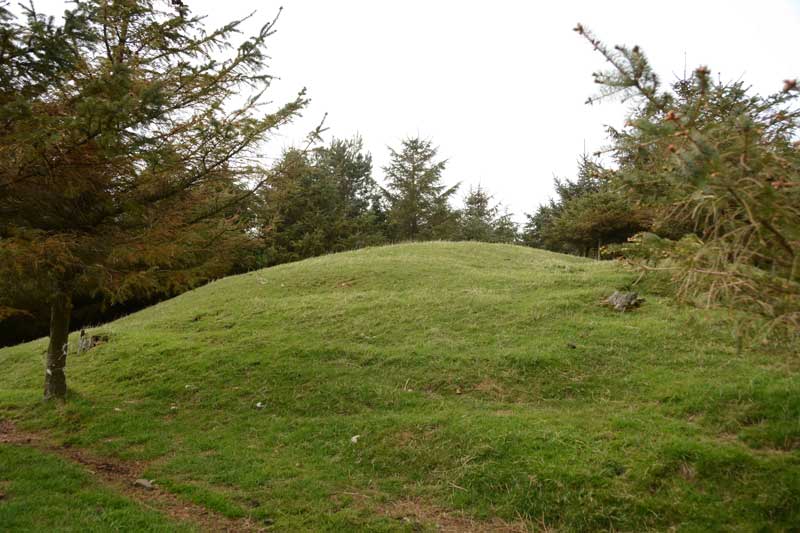
Horseshoe Wood Settlement submitted by Anne T on 9th May 2015. From a different angle the mound appears to have tiered banks which run around it (although always happy to be corrected as to what these features are).
(View photo, vote or add a comment)
Log Text: Horseshoe Wood Settlement, Hownam, Scottish Borders: After having parked in the sleepy little hamlet of Hownam, a footpath called The Street sets off near the village/community hall, leading off to the left of the main road up into the hills.
Just starting up The Street, there is a field to the right hand side of the road which holds what looks like another standing stone, so we stopped to investigate.
Continuing, we then passed a couple of houses on a gravelled roadway the footpath enters farmland which rises reasonably gently up towards Horseshoe Wood. At the time of our visit, the footpath was covered in manure (obviously had a herd of cattle on it recently). The lambs were very curious as to who these strangers were who were walking through their land, only moving from the warm soil of the path at the very last minute.
Horseshoe Wood runs to the left of the footpath, contained within a stone wall. Towards the higher end of the wood the wall has been demolished in two places and through this the mound of the settlement rises distinctly behind it.
Exploring, we found it to be an elongated mound, made even clearer by the fact it has no trees growing on it, with two circular scoops taken out of the left hand side; the first has a small tree growing out of it.
Curious, as this mound is relatively near the Standing Stone (only a couple of hundred metres), we took photographs and tried to find out more after our visit, but couldn't - but the description sounded identical to the RCAHMS/Canmore record of a scooped settlement nearby.
We thought perhaps this mound had been missed because it has been hidden by the wall and the trees within the wood.
If anyone can shed any further light on this mound, I'd be delighted to hear more.
Jedburgh Ancient Christian Stones
Date Added: 24th May 2015
Site Type: Ancient Cross
Country: Scotland (Scottish Borders)
Visited: Yes on 4th May 2015. My rating: Condition 3 Ambience 4 Access 5
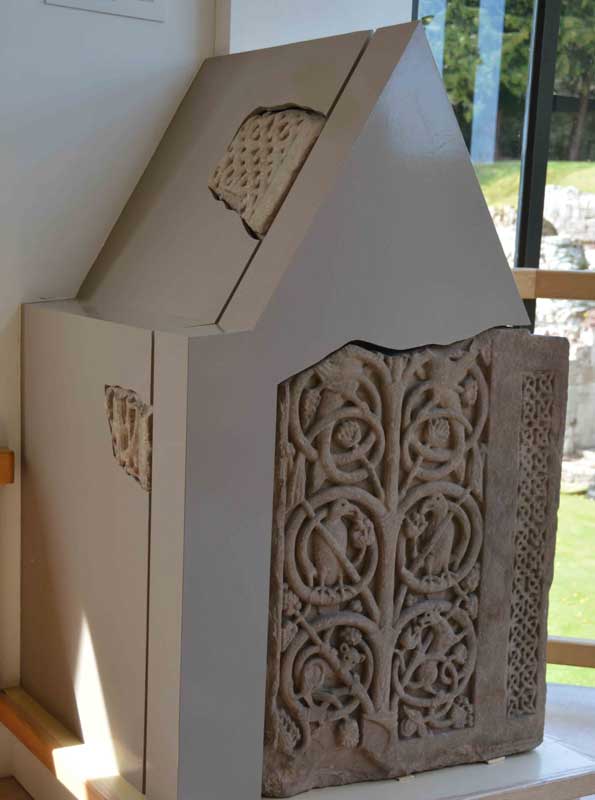
Jedburgh Ancient Christian Stones submitted by Anne T on 8th May 2015. The impressive 8th century shrine with its intricate carvings, displayed on the first floor of the Visitor Centre adjacent to the Jedburgh Comb.
(View photo, vote or add a comment)
Log Text: Jedburgh Early Christian Stones: We've driven past Jedburgh, with the Abbey looming high on the hill to our left, on many an occasion but never stopped to take a closer look.
Turning left into Jedburgh, we were surprised to find that not only was the parking free, but there was free Wi-Fi throughout the town (although the password to connect varies as to the cafe/facility you are using at the time).
Paying the fee to get into the Abbey, we entered the Visitor Centre, and was astonished (and pleased) to find Anglo-Saxon cross fragments displayed on the walls of the stairwell and also on the first floor. These hadn't been mentioned on their website, and were definitely a nice bonus.
Having photographed the early Christian stones (including the wonderful 8th century shrine fragments) we made our way into the Abbey. I love looking at old monasteries and churches and really enjoyed our time here. It was sunny and warm, and we amused ourselves for a little while by trying to re-create a couple of the photographs in the guide book (almost, but not quite - I'm not that talented!).
No refreshments in the Abbey/Visitor Centre but a string of nice cafes opposite.
I would like to come back when the various museums are open. There is a lot to see in and around the town.
We cut the visit reasonably short as we wanted to head out into the hills to look at Standing Stones not too far away.
Would definitely recommend a visit.
Woden Law
Date Added: 26th May 2015
Site Type: Hillfort
Country: Scotland (Scottish Borders)
Visited: Yes on 23rd May 2015. My rating: Condition 3 Ambience 5 Access 3
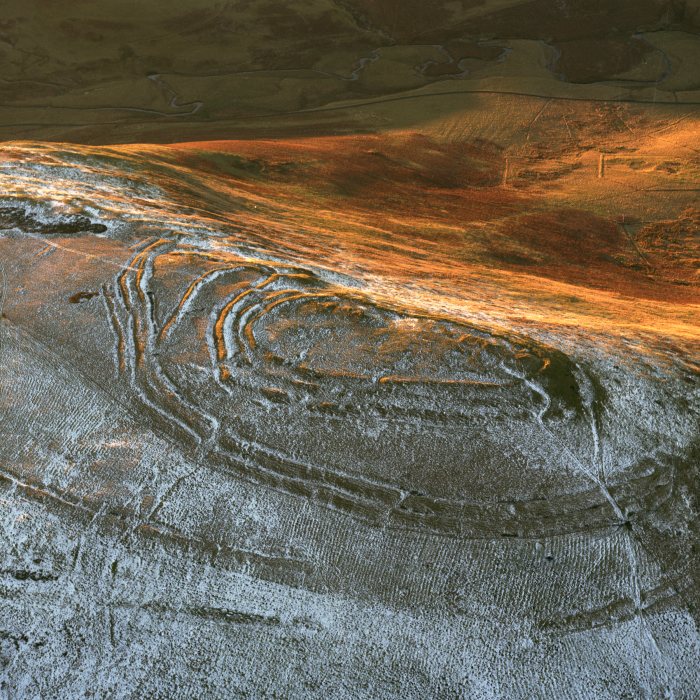
Woden Law submitted by dodomad on 8th Jan 2005. Aerial view of Woden Law fort, Scottish Borders. SC677288
Crown Copyright: RCAHMS
(View photo, vote or add a comment)
Log Text: Woden Law Hillfort, Scottish Borders: Firstly, congratulations are due to husband, Andrew, for getting me up onto this high, remote and very beautiful spot. The climb was certainly very worth it!
Driving back down from Dod Law/Chatto Hill, we arrived back at Pennymuir Roman Camps, turning left down the minor road passing Towford Outdoor Education Centre. Splashing through the ford through the wonderfully meandering Kale Water, we parked just before the t-junction a couple of hundred yards further on (there is room for 2 cars). Dere Street ran in both directions to our right hand side, doing a dog-leg past the camps and back up towards Trestle Cairn to the north-west, and running east-south-east, heading up into the gap between the hills of Hangingshaw Hill/Langside Law to the left with the impressive Woden Law to the right. Those Romans certainly knew a trick or two, as the road followed the lowest angle up the slope.
Setting off, I could hear a dog barking and eventually spotted two people descending the steep western slope of Woden Law with their three dogs. We kept to Dere Street.
At the top of the gap between the hills a small building was visible to the left of Dere Street, and heading towards this it was a slow, steady climb up easy grassy paths with the ditches of the road visible in parts. Just before reaching the building, at this point, it wasn’t clear if we could get through the newly built wire/barbed wire fence across the fields at this point(we've had problems of long stretches of fence lines with no gates before) so rather than go through the gate and follow the path, we trudged straight up the side of Woden Law which was rather steeper than it initially looked. I almost lost my nerve on this slope, having to step between tussocked lumps with holes in between. We soon reached the first bank and ditch of the Roman siege works on the lower slopes of the eastern side of the hill fort – but still about fifty feet below the summit. It became clear we should have kept to the path which was wide, grassy and easy walking!
Passing through a further set of fortifications, we reached the top of the hill. There was clearly a lot going on here – lumps and bumps and banks and ditches everywhere. Since coming home, we found the 1950 Excavation Report by the late Sir Ian Richmond and Professor St. Joseph, which has a plan of the fort in it. It would have been useful to have had this during our visit as we could have interpreted more of what we were seeing at the time, but has helped when cataloguing my photos. We started at the northern-most edge of the fort and worked our way over to the southern edge, taking note of the ramparts and structures on our way. At one point we noticed the rabbits had burrowed into the outer bank of the outer annexe and saw the high built up of turf on top of the stones used to create the wall.
The wind was persistent, and I was too much of wimp to go to the very edge of the fort, so Andrew took a few photographs perched on the outer bank.
Most definitely worth well the climb. Andrew wished he'd had his hang-glider.
Dodlaw Burn
Date Added: 26th May 2015
Site Type: Standing Stone (Menhir)
Country: Scotland (Scottish Borders)
Visited: Yes on 23rd May 2015. My rating: Condition 3 Ambience 4 Access 3

Dodlaw Burn submitted by Anne T on 26th May 2015. Standing behind the 'entrance pair' of stones looking west over the Kale Water valley.
(View photo, vote or add a comment)
Log Text: Dodlaw Burn Standing Stones and Cairns, Scottish Borders (alternative name = Chatto Hill Standing Stone): I guess we’ve become more than a little bit fascinated by this part of the Scottish Borders, probably because it’s easy to get to (about an hour from our house), there are very, very few people around (apart from the odd farmer and cyclist) and there are so many features/sites marked on the map.
Husband Andrew spotted an area marked on the map as having ‘standing stones and cairns’ relatively near to Woden Law hillfort, which we both wanted to see. So, on a sunny Saturday, we set off north.
Taking a different route from Jedburgh through Oxnam, we ended up back at the Pennymuir Roman Camps, continuing past them up towards Chatto Craig and Tronshaw Hill. The minor road passes over a cattle grid near Chatto/Upper Chatto, and immediately over the grid there is a sheep-fold with room for several cars to park without blocking access to the field.
A gate gives access onto the field from here and the track climbs up and off to the left hand side of the field, up past a small wood to the left hand side then levels off in the area between Dod Law hill to the right and Little Heuch Law to the left. Almost immediately, we were struck by what appeared to be cairns on the eastern flank of Dod Law and in the flat area to the left hand side of the track, what could possibly be a large hut circle and a cairn or two. Because of the depth of the tussocked grass, we could walk the bank of the ‘hut’ but couldn’t really capture it in a photograph. More research to done on the RCAHMS site in this area, me-thinks (there are lots of ‘dots’ on Canmore mapping here, but you can’t click on a dot and bring up the information, so it’s going to take some time). We did take grid references, and I’ll look at these when there is more time (and less gardening) to do. (Note: a subsequent look at the Canmore site reveals this circular feature is a most probably a sheepfold).
Continuing up the gently slope between the hills and crossing over the small ford over the Dod Law Burn, the standing stone appears on the brow of the hill just above you. Following the path, it becomes clear on reaching the top that there are three stones; two sit close together as a sort of entrance. The third sits low and flat to the ground to the east.
There are in fact three cairns to the north of the third stone, at grid references NT 77795 16810 (measures 5.6 metres in diameter, 0.4 metres high), NT 77800 16814 (immediately to the north east, 4 metres in diameter and 0.4 metres in height), and NT 77799 16820 (to the north, 4.6 metres in diameter and 1.5 metres in width). I’m glad we had the GPS device. None of the cairns could easily be photographed, but we could definitely see them with the naked eye. Whilst the 1999 record says they stand 0.4 metres above the land surface, I reckoned they were about 20 cms higher, probably because of the tussocks of grass around them. Thank goodness for having taken part in the Davy’s Lee Level 1 and Level 3 surveys recently, as I began to get my eye in to look at lumps and bumps and identify changes in grass height and colour, which gave clues as to the banks surrounding the cairns.
Above us to the east rose a cairn on Little Heuch Law.
Preston Cleugh Fort
Date Added: 3rd Jun 2015
Site Type: Hillfort
Country: Scotland (Scottish Borders)
Visited: Yes on 30th May 2015. My rating: Condition 2 Ambience 4 Access 4
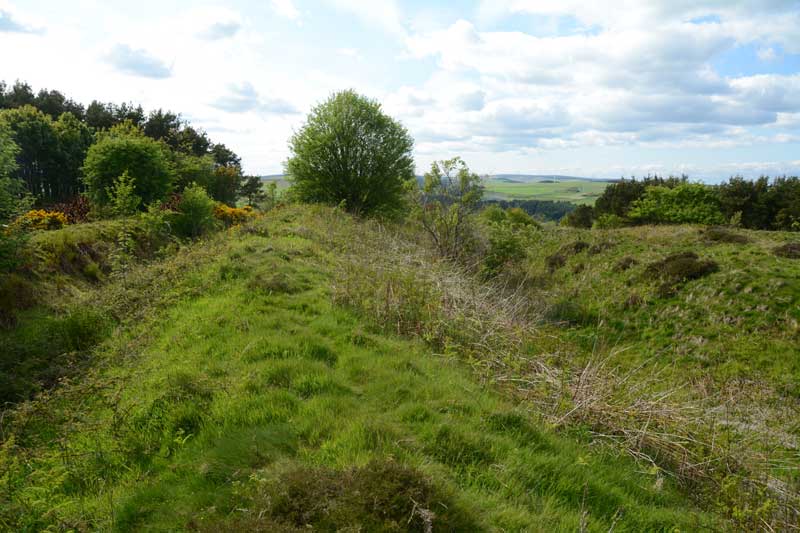
Preston Cleugh Fort submitted by Anne T on 2nd Jun 2015. Standing at the south east corner of the fort looking west.
(View photo, vote or add a comment)
Log Text: Preston Cleugh Fort, Scottish Borders: On our way to Edin’s Hall Hill Fort & Broch, having stopped in Duns for a late lunch, this fort was right next to the road on our way, so we decided to stop and take a closer look. Taking the A6112 through Preston, just after where the B6438 forks off the A6112 on the right hand side, there is a forestry track leading into Preston Plantation, where it’s possible to park against the verge along the edge of the track, close to where it meets the main road. There were signs all along this track saying ‘Entry Prohibited’, ‘Forestry Operations’, ‘Do Not Climb On the Timber Stacks’, but only a short way up this forestry track was a sign saying the ancient monument was 127 metres away. Stepping over a small bank and wading through growing ferns and weeds (which will be knee high in a few weeks), the double bank of the fort rose out of the ground before us. These defensive banks and ditches continue along the west and south sides, the north and east being formed by natural slopes.
There is a clear entrance-way to the north western side. To the north east, Cockburn Law Hill Fort rises high above this fort.
The Canmore site notes (site 58616) say that this fort measures 77m by 57 metres internally, having been built in two phases: the first phase being a double earthern rampart and ditch with its entrance on the western side; the second included the construction of a stone rampart on the line of the inner rampart, continuing along the entire perimeter of the fort, with a new entrance being cut on the eastern side.
A peaceful spot, worth stopping off to visit, particuarly with a print of the plan from the Portal 'Drakemuir Forts' to understand what we were seeing. Thanks, Portal, another good place to visit.
Edin's Hall
Date Added: 2nd Jun 2015
Site Type: Broch or Nuraghe
Country: Scotland (Scottish Borders)
Visited: Yes on 30th May 2015. My rating: Condition 3 Ambience 4 Access 3
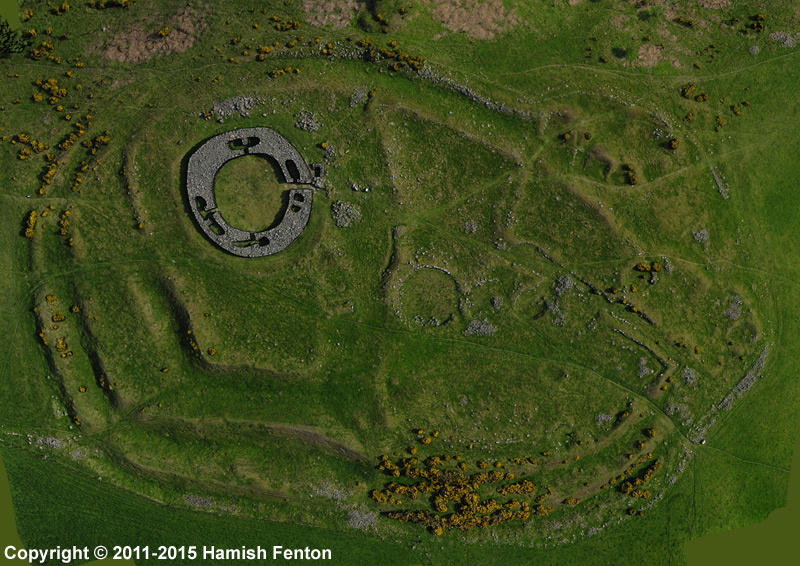
Edin's Hall submitted by h_fenton on 30th Mar 2015. Edin's Hall Broch / Fort / Settlement. Vertical image from 3D model which was created using 75 Kite Aerial Photograph s.
Photos taken: 19 May 2011
3D model created: March 2015
(View photo, vote or add a comment)
Log Text: Edin's Hall Fort & Broch, Scottish Borders: Having stopped at Duns for refreshments, there is a small car park, large enough for 3 to 4 cars just off the A6112 at grid reference NT 78933 60957 which gives access to a forest/river walk. At the car park, there is a signpost for the Broch, saying ‘2 ¼’ but two and a quarter what? Miles, kilometres? This contradicted our map which indicated the walk was just over a mile.
Walking through woodland, along an easy forest track, there is a sign saying: ‘Free range children and animals’ so whoever owns this land has a sense of humour (also try and spot the tree with personality by the car park - it has been given eyes, ears and a nose!).
Down the path, we approach the Whiteadder Water (yes, there is also a Blackadder) we come across the Elba foot suspension bridge, with a sign saying ‘only two people to cross at any one time. No jumping on the bridge’. It indeed moves up and down as you walk over. There are stunning views of vertical bedding planes forming the banks of Whiteadder Water at this point, with water tumbling over the rocks.
Continuing past the house, through its orchard, past the barking dogs and geese and hens, onto the flood plain with a bank to our left hand side which keeps the curious cattle at bay, we followed the river. Climbing up the bank towards the pylons running overhead led onto two stiles (stone steps) over the stone walls. This was somewhat of a challenge for me on the way there, having to sit on top of the wall and swing my legs over, but on the way back, I’d got bored of being frightened and actually managed to walk across them like a normal walker.
A pleasant walk up to the hill fort and broch, with a herd of cattle looking lazily down on us from the top of the hill in the first field and a flock of sheep and their now large lambs in the second. Rather than scramble across a third stile there is a gate in the wall higher up the slope which we used to gain entry to the field with the fort. The Duns History Society describe this walk as ‘slightly strenuous’ but I’d disagree. It’s pleasant enough, although the hillside immediately up to the fort is a little steeper in practice than it looks on the ground.
Following the track into the fort, there are some obvious defensive banks and ditches which rise gently up the hillside as you follow the trackway, with clear hut circles, large and small. There also appears to be the remains of some square stone structures which (according to the interpretation board) indicate later (more recent use of the site). The views down to the river valley were great, as was Cockburn Law Hill Fort rising still high above us – we drove past this on the way back to Abbey St. Bathans and will come back to explore this on another visit [note to self, use the A1 to Berwick then cut across country to Preston rather than use the A697 road from Morpeth – this was very slow].
The broch itself is impressive as you first approach – the entire lower few courses of stone are still in place round the entirety of the circular structure; there is only one entrance into the broch on its eastern side.
It is fascinating to walk around, as there are all sorts of internal chambers, and even the beginnings of a small set of stairs in an internal chamber on the south-western side of the broch. On the north-western side, where the ground starts to slope away towards Whiteadder Water, the walls are particularly thick; we guessed this was either because the walls needed reinforcing at some point to stop them sliding down hill, or it’s an internal chamber that’s been filled in.
The late afternoon/early evening sunshine brought out the contrast between the defensive banks and ditches and I could have spent a lot longer walking around here. If there had been time, we might have followed the footpath through the west-south-western entrance to the fort all the way up to Cockburn Law Hill Fort. The site appears to be really well cared for, with all the bracken being cut back.
The Yarrow Stone
Date Added: 29th Jun 2015
Site Type: Standing Stone (Menhir)
Country: Scotland (Scottish Borders)
Visited: Yes on 27th Jun 2015. My rating: Condition 3 Ambience 4 Access 4
The Yarrow Stone submitted by mafenty on 28th Mar 2007. The Yarrow Stone
(View photo, vote or add a comment)
Log Text: The Yarrow Stone, Yarrow, Scottish Borders: From Selkirk, we took the A708 towards St Mary’s Loch and Moffat. There was a diversion coming out of Selkirk, due to roadworks, so we had to double back to get onto the A708. Passing through the hamlet of Yarrowford, the road runs by Yarrow Water to the left hand side – a very pleasant, fertile valley. Reaching Yarrow, the kirk was signposted to the right hand side of the road, and a small grass-crete area in the centre of a triangle of roads made it possible to stop and get our bearings. Continuing westwards along the A708, we kept our eyes peeled for standing stones which, according to the Canmore notes, were visible from the road, but didn’t see anything. We reached the hamlet of Yarrow Feus before turning back and retracing our steps towards Yarrow.
We found the signpost for Whitefield (a farm) easily enough on the left hand side of the road, and there was a small layby big enough for two cars to park by the side of the A708. From here, a track led up to a gate into a field, where the Yarrow Stone was visible surrounded by a wooden fence to protect it from stock (there were none in the field at the time of our visit). The grid reference was spot on (thank you!) and it was an easy, short walk up the stony track.
There is a small plaque which reads: “The Yarrow Stone. This inscribed stone records the grave of two Christian British princes who lived during the 5th or 6th century AD. It was uncovered around 1803, when up to twenty large stone cairns were removed from a former moor, known as Annan Street, to create arable fields. The inscription is in Latin and can be read as: (+) HIC MEMORIA PE(RP)ETV(A) {I}N LOCO INSIGNISIMI PRINCI PES NVDI DVMNOGENI HIC IACENT IN TVMVLO DVO FILI LIBARALI{S} which translated means “this is the everlasting memorial. In this place lie the most famous princes Nudoss and Dumnogenos. In this tomb lie the two sons of Liberalis.” After the end of Roman Britain, in the 5th century AD, much of the Southern Uplands became part of the British Kingdom of Strathclyde. St. Ninian was the force behind Christian Missionary work in the region, which sought to convert the population through its leaders. This site may already have been a place of ceremonial importance in prehistoric times, but the Yarrow Stone and other burials in stone lined graves (cists) suggest that it was also valued by early Christians.”
From here it was a short hop to find the Warrior’s Rest standing stone.
Warrior's Rest
Date Added: 29th Jun 2015
Site Type: Standing Stone (Menhir)
Country: Scotland (Scottish Borders)
Visited: Yes on 27th Jun 2015. My rating: Condition 3 Ambience 4 Access 4
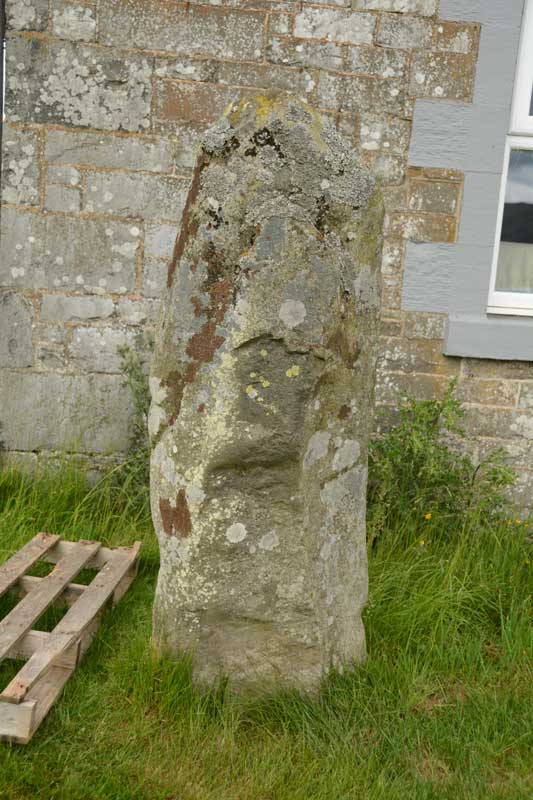
Warrior's Rest submitted by Anne T on 29th Jun 2015. A close up of the Warrior's Rest east face, but no cup marks that I can see. I wonder if the report of these cups got muddled with the Glebe Stone, just down the road, as I could see two cups on its eastern face.
(View photo, vote or add a comment)
Log Text: Warrior Stone, Yarrow, Scottish Borders: The Canmore Site (no. 53054) notes say that this stone is “at the south east corner of the cottage known as Warrior’s Rest, 300 yards west of Yarrow Church, there is a standing stone measuring 5ft 3ins in height, 5ft 9ins round the base and 4ft around the shoulder. The top is pointed.”
As the crow flies, it is just over 700 metres east of the Yarrow Stone, back towards Yarrow village. We spotted the small white signpost to Warrior’s Rest cottage at the left hand side of the road and stopped at the entrance. We couldn’t see any standing stone in the vicinity at all, even climbing the steps to the nearby war memorial just to the west of the cottage to see if we could spot anything. In the end, I walked up the track towards the cottage and spotted what appeared to be the top of a small standing stone peeking out above one of the two cars parked on the driveway.
Having come all this way, I was disappointed not to be able to see the stone, so decided to walk up and knock on the door. The curtains were drawn and the door to the garage was open, but despite knocking and calling out, I got no response, so decided to be cheeky and take a couple of photographs (and if anyone came, I’d explain). The stone literally stand a couple of feet away from the front bedroom window – whether its still in its original place and the cottage was built next to it, or the stone has been relocated next to the cottage was difficult to tell.
The Canmore notes also say there are two, previously unreported, cup marks on the eastern side of the stone, although I did quickly examine the stone for any cup marks, but didn’t see any. Usually my camera can pick up on things the eye finds difficult to differentiate at the time, but examining the photos this morning, I couldn’t see anything. I wonder now, at the time of writing, if this has been confused with the Glebe Stone, as I did see two cup marks on the eastern face of this stone.
Glebe Stone
Date Added: 29th Jun 2015
Site Type: Standing Stone (Menhir)
Country: Scotland (Scottish Borders)
Visited: Yes on 27th Jun 2015. My rating: Condition 3 Ambience 4 Access 4

Glebe Stone submitted by mafenty on 6th Feb 2007. The Glebe Stone looking to the west.
(View photo, vote or add a comment)
Log Text: The Glebe Stone, Yarrow, Scottish Borders: parked at NT 35172 27575
Driving back westwards from Warrior’s Rest standing stone, we immediately spotted the Glebe Stone in a field to the north of the road – how had we missed it the first time? With granddaughter’s pushchair in tow, we didn’t dare walk down this narrow, busy, country road, so we parked in the gateway to a barn at grid reference NT 35172 27575. Just as husband got out of the car to see how to access the field, a girl and her dog drove past the car to the barn behind on a quad bike, so I hopped out to explain what we were doing. “No, you’re very welcome to look. There’s a gate a 100 yards or so down the field”, she told me.
This stone, the Canmore Site no. 53061 notes tell me, sits 530 yards ENE of the Yarrow Stone and sits 40 yards north of the main road. These notes say “the stone has been fenced in (although the fence is not now in place) and measures 4ft 6ins in height, from 2ft 7 ins to 3ft 10ins in width and 1ft 4ins in thickness. The broader sides face WNW and ESE. On the latter side, near the base, there are two doubtful cup marks, one measuring 3ins in diameter and ½ inch deep, another 4ins by 5ins and 2 and ½ ins deep. Around the stone there was formerly a large cairn covering a quantity of decomposed bones.”
It was an easy walk up a shallow grassy slope to the stone, and I went all around taking photographs. There is a pleasant view over to Yarrow Water (this stone sits closest of the three stones close together – this stone, the Yarrow Stone & Warrior’s Rest stones) just the other side of the road.
I definitely saw some cup marks on the eastern face of the stone – photographs here to see what others think.
From here, it was back into Selkirk and onto Melrose to see the Abbey before going onto the Kelpies at Falkirk. A great day out!
Menzion
Trip No.5 Entry No.2 Date Added: 14th Aug 2016
Site Type: Standing Stones
Country: Scotland (Scottish Borders)
Visited: Yes on 10th Aug 2016. My rating: Condition 2 Ambience 3 Access 5
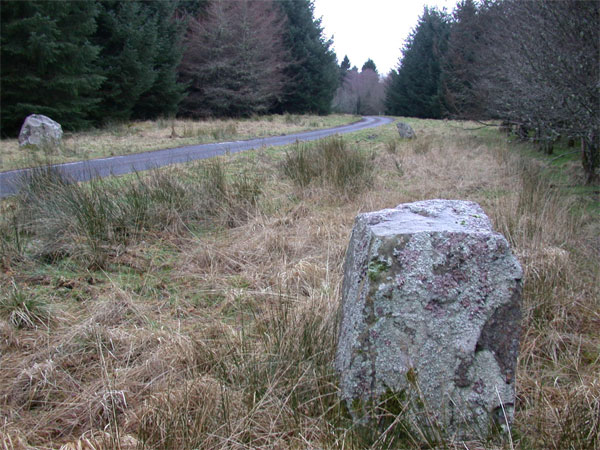
Menzion submitted by nicoladidsbury on 28th Jan 2005. This photo tries to capture the group of three stones, that make up the Menzion site.
This is a beautifully, quiet place. The stones are not very big, less than a metre high, but remarkable because they are absolutely covered in lichens, as are the branches of the over hanging trees. A sure sign of the purity of the air.
(View photo, vote or add a comment)
Log Text: Menzion Stones, Tweedsmuir: I confess to being really confused about this site (not too difficult, really!). Whilst the map showed three standing stones in close proximity at the sides of the road (2 at the western side, 1 on the eastern side) we could only find 2, one on either side of the road. Of the photos on the Portal, we couldn’t find the square topped one. Somehow we’d managed to misplace our GPS, so I felt a bit helpless and frustrated at having driven all this way and missed some of what we’d come to see.
According to the Canmore site, the grid references are NT 0952 2397, NT 0949 2398, NT 0953 2399. Getting out of the car into the ‘Scotch Mist’, I walked up and down the grass verges, peering into the tall undergrowth, for a couple of hundred yards trying to find the location of the third stone. We saw the stones at NT 0952 2397 and NT 0949 2398. The latter was almost hidden by a long, low conifer branch.
Had the sun been out, there would have been great views down to the River Tween to the north-west.
Dreva Craig
Trip No.5 Entry No.5 Date Added: 18th Aug 2016
Site Type: Standing Stone (Menhir)
Country: Scotland (Scottish Borders)
Visited: Yes on 10th Aug 2016. My rating: Condition 2 Ambience 4 Access 4
Dreva Craig submitted by austenjohnreid on 29th Apr 2010.
the east side of the hill is littered with boulders & longstones, there is also some remains of a stone age stuff too much to photograph.
(View photo, vote or add a comment)
Log Text: Dreva Craig, hillfort and settlements, Scottish borders: OK, so it rained last year on my birthday. This year, the rain was equally as torrential, so we hopped from site to site. This was our last stop of the day, after (trying to visit) Tinnis Castle/Hillfort and Altarstone. There is a parking space for one or two cars next to the gate to the field, and a stile over the fence, although it proved easier to open the gate. Tramping through the knee high undergrowth, it was easy to reach the rocky outcrop on the ridge leading to the fort itself, but the surface of the rock was so wet it was quite treacherous. Husband would have been happy to continue, but I wimped out when I spotted the huge bull 50 yards away, opting to take a few photographs and retreat to the warmth (and safety) of the car. We plan to come back to this area when the weather is drier. This really looks like a fascinating site, with lumps and bumps on both sides of this minor road. The Canmore record tells me that there is a fort (photographed), defended by two stone walls, alongside three settlements. Had the sun been out, there would have been really fantastic views down to the River Tweed to the south.
Midshiels Standing Stone
Trip No.29 Entry No.7 Date Added: 31st Jul 2017
Site Type: Standing Stone (Menhir)
Country: Scotland (Scottish Borders)
Visited: Yes on 3rd Jun 2017. My rating: Condition 3 Ambience 4 Access 4

Midshiels Standing Stone submitted by Anne T on 4th Jun 2017. This is the nearest we could get to the standing stone on the evening of our visit. The field was full of quietly grazing sheep but many lively, curious young bullocks. The minute we started to open the gate, they were racing towards us.
(View photo, vote or add a comment)
Log Text: Midshiels Standing Stone, Hawick: We'd arrived (unknowingly) in Hawick on their Riding of the Marches day. The shops were shut and the town was almost deserted. Having visited some other sites on the southern side of Hawick, we decided to stop off to see this standing stone and cairn on the way back home. Following the curious one-way system though Hawick, we ended up on the Borders Abbey Way heading north-east out of the town. At Bucklands, we found where the entire town was - at a community centre at the edge of the town. A marshall stopped us and told us we wouldn't be able to get any further up the road as the procession of horses was coming through. Doubling back through the industrial estate, we took the A698 out of town, turning left over the picturesque Hornshole Bridge, rejoining Borders Abbey Way a few hundred yards before the entrance to Midshiels Farm.
A couple of hundred yards further north-east along the road, there was a large passing place, so we hugged the car into the hedgerow and hopped out. About 50 metres further back, on the other side of the road, a gate let us into the field leading to the dismantled railway embankment to the west. Following the left hand hedge-line along, we came to another gate, just before a tall brick bridge leading under the railway line. This gate gave access to the field with the standing stone and cairn.
However, the field was full of gently grazing sheep and lots of lively, curious bullocks along with what looked like a very large bull. My hand went onto the gate and they were running towards us. I elected to use the zoom lens on the camera, and was really disappointed not to have seen this standing stone closer up. But there is lots to see in this area, so undoubtedly a return visit will be in the offing at some point in the not too distant future.
Burgh Hill Stone Circle
Trip No.29 Entry No.4 Date Added: 31st Jul 2017
Site Type: Stone Circle
Country: Scotland (Scottish Borders)
Visited: Yes on 3rd Jun 2017. My rating: Condition 3 Ambience 4 Access 3
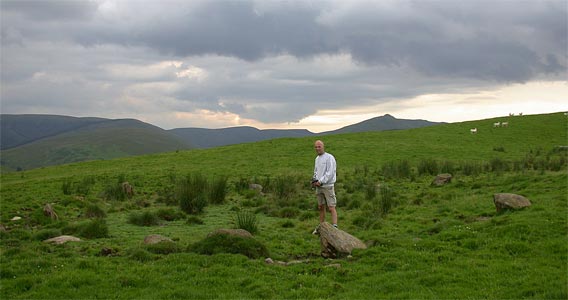
Burgh Hill Stone Circle submitted by nicoladidsbury on 17th Mar 2004.
(View photo, vote or add a comment)
Log Text: Burgh Hill Stone Circle, Hawick: After visiting Lord's Tree and Ca Knowe Cairns, we headed off towards Teviothead and some wild, lonely countryside. There is a track leading up the hill towards the stone circle (and the hill fort beyond), at NT 47365 06725, with parking for 2-3 cars opposite.
Following the track up the (reasonably steep) hill, we took the left hand fork and followed the mowed grassy track towards the stone circle. The circle lies just past the first peak with rocks outcrops to your right, but not as far as the fort. We went past the stones at first, having climbed too high up the hill, but Andrew found a metal pole with a large aluminium star attached to it, presumably marking this as an archaeological site.
Looking at the site on UK Grid Reference Finder, the circle lies in between two small banks running in very shallow arcs. The stones of the circle seem to lie in a dip with a small bank around. It reminded me very much of a cairn circle rather than a stone circle, as none of the stones seemed to be worked in any way, and they were all comparatively small. I note the Canmore record for this site says it's been re-designated a Stone Setting rather than a stone circle.
Having stayed to enjoy the views, and also photograph the Dod settlement from above, we climbed up to the fort, where it was VERY windy (but thankfully the wind was warm).
Lord's Tree (Hawick)
Trip No.29 Entry No.2 Date Added: 31st Jul 2017
Site Type: Cairn
Country: Scotland (Scottish Borders)
Visited: Yes on 3rd Jun 2017. My rating: Condition 3 Ambience 4 Access 4
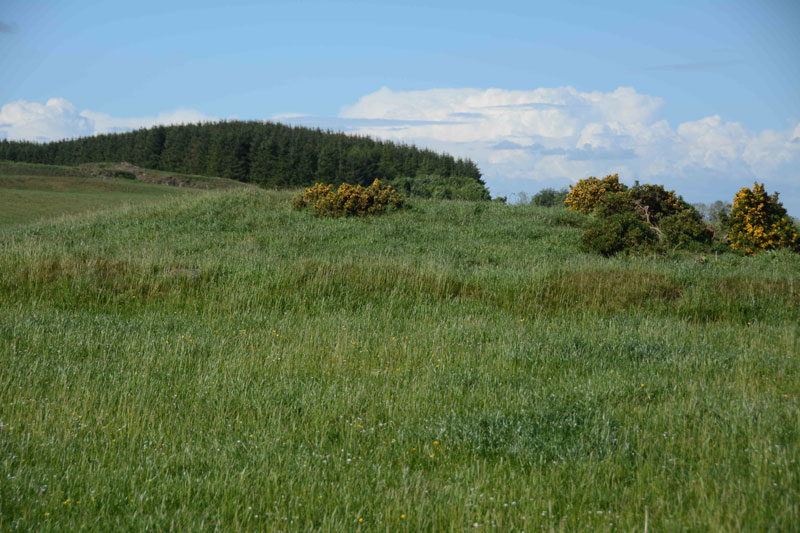
Lord's Tree (Hawick) submitted by Anne T on 4th Jun 2017. Standing at the southern side of the cairn looking up the slight slope to the low mound of the cairn. The circular bank around the cairn clearly visible.
(View photo, vote or add a comment)
Log Text: Lord's Tree Cairn, Hawick: We arrived in Hawick, intending to buy a map, but the majority of the shops (apart from the bookmakers, charity shops and 1 café, were closed (looking at the opening times, they largely shut at 2pm on a Saturday. The town seemed deserted apart from a few tourists. We later found out that most local people had gathered near the community centre for the Riding of the Marches.
Relying upon the Trigpointing UK maps (good job there was a phone signal!), we navigated our way through the town (stopping off to look at The Mote on the way), past the golf course and out into the glorious open countryside with the hills beyond.
This cairn appears as a slight bump at the top of a small rise of a hill; it's unmistakably a large, low cairn, and the lush green grass and wild flowers invited a walk through the meadow towards it.
Completely circular, there is a low bank surrounding the cairn. Shame the old Lord's Tree wasn't there. Lovely view down to Ca Knowe Cairn further south.
The Dod
Trip No.29 Entry No.6 Date Added: 31st Jul 2017
Site Type: Ancient Village or Settlement
Country: Scotland (Scottish Borders)
Visited: Yes on 3rd Jun 2017. My rating: Condition 2 Ambience 4 Access 5

The Dod submitted by Anne T on 5th Jun 2017. The Dod settlement as seen from the slope just to the east of Burgh Hill Stone Circle.
(View photo, vote or add a comment)
Log Text: The Dod, near Bugh Hill Stone Circle and Hillfort: It was amazing what could be seen of this site from the slope just below Burgh Hill Stone Circle. Looking at the plan on Canmore, it is cut in two by the syke by the farm to it's south, but what remains, looking at the settlement from the road, are deep ditches and reasonably high banks.
The area is boggy, but the settlement can be reached by entering the field at its north-eastern end, walking westwards along the fence line next to the gate, then cutting across the field at the far end. For those not keen on boggy ground, a lot can be seen from the road.
Thankfully (after Burgh Hill Hillfort) The Dod was not windy! The sun was very strong at the time of our arrival here, and I struggled to avoid flare even using a polaroid and UV filters together. Was really pleased to have seen this site, but with so many other settlements and hill forts in the area, how to fit them all in? We decided to call it a day, calling in at Midshiels Standing Stone and Cairn on the way back home.
Burgh Hill Hillfort
Trip No.29 Entry No.5 Date Added: 31st Jul 2017
Site Type: Hillfort
Country: Scotland (Scottish Borders)
Visited: Yes on 3rd Jun 2017. My rating: Condition 3 Ambience 5 Access 3
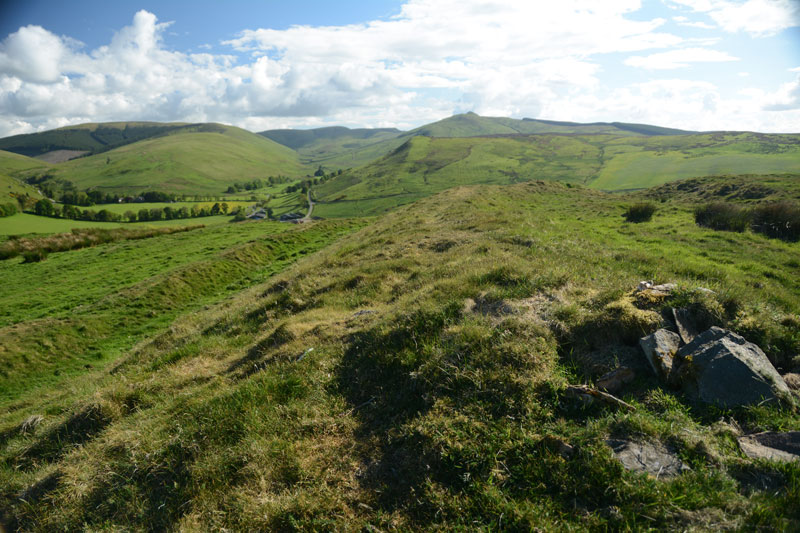
Burgh Hill Hillfort submitted by Anne T on 5th Jun 2017. Standing half way along the eastern upper bank of the fort, looking south west towards the hills beyond.
(View photo, vote or add a comment)
Log Text: Burgh Hill Hillfort, Scottish Borders: What is a 'bit more of a walk' for me is probably a 'short walk on a footpath' for others, but even so, this was a brilliant place to have visited.
With Burgh Hill Stone Circle (or possibly a cairn circle?) not far away, it was worth the additional short trek up to the south west summit of Burgh Hill. Goodness it was windy, although thankfully, as it was a nice warm spring/summer day, the wind was at least warm.
On the western side of the hillfort, the ground (as at Woden Law) dropped away sharply, making me take a quick step backwards to admire the views over the Allan Water valley below.
There are clear internal boundaries/banks/walls and a couple of hut circles, although these didn't come out very clearly on the photographs I took. There was a solitary large (standing) stone which didn't seem to be associated with any internal features.
The double banks and ditches on the south, east and northern sides of the fort were really visible, made of stone and earth, with two clear entrances to the north-east and south-west.
Caddrounburn Calvert
Trip No.31 Entry No.1 Date Added: 26th Jun 2017
Site Type: Ancient Village or Settlement
Country: Scotland (Scottish Borders)
Visited: Yes on 24th Jun 2017. My rating: Condition 2 Ambience 4 Access 5

Caddrounburn Calvert submitted by Anne T on 26th Jun 2017. Standing near the north west corner of Enclosure B, looking south west towards Liddel Water. The ditch between Enclosure B and Enclosure B can be seen to the middle right of the photo.
(View photo, vote or add a comment)
Log Text: Caddrounburn Calvert, Scottish Borders: [Note: whilst the site can be seen from the road by Liddel Water, it is a short climb up the slope to walk round the exterior walls of the settlement. I found the tussocks of grass and hidden lumps of stone challenging on my ankles, but took a walking pole to help.]
Following the road to the west of Kielder Water, this twists and turns gently through the countryside. The border here takes some interesting lines, but we ascertained we were just into the Scottish Borders. This fort/settlement is in a lovely spot overlooking a bend of Liddel Water. The grass was almost knee high, but it was still possible to make out Enclosure B from the road. To the western side of Enclosure B, there was a deep ditch and the start of another boundary feature, but the grassy was too long and lush to make out much of Enclosure B at this time of year.
We parked on the south side of the road at NY 58270 98319, where it widens out very slightly on a bend (avoiding the sheep and their large lambs who were totally unperturbed by the car) and headed up the slope to Enclosure B.
The banks are high (up to 1.5 metres) in places, clearly made up of stones and earth. Whilst not quite a square, the corners are well rounded and there is an about 8 foot wide entrance at its south western corner. The banks appear to be between 3 to 4 meters wide, including the tumble at either side. There was a north-south bank from about the middle of Enclosure B to about half way down the enclosure, before it petered out. I (stupidly) thought this was the division between Enclosure A & B, but looking at the site on UK Grid Reference Finder once I got home, I was sadly mistaken! We’d missed Enclosure A completely, although I did spot the ditch dividing the two areas. The grass was very lush and thick, and any banks of Enclosure A were certainly hidden from both the road and Enclosure B. I’d love to see this site again in the winter.
